B0041VYHGW EBOK (90 page)
Authors: David Bordwell,Kristin Thompson

Alternatively, the filmmaker may decide to build the entire film out of long takes. Hitchcock’s
Rope
is famous for containing only 11 shots, most running between 4 and 10 minutes. Similarly, each scene in
Winterwind, Agnus Dei, Red Psalm,
and other films by Miklós Jancsó is a single shot. In such cases, the long take becomes a large-scale part of a film. And in such a context, editing can have great force. After a seven- or eight-minute shot, an elliptical cut can prove quite disorienting. Gus van Sant’s
Elephant
traces events around a high-school shooting rampage, and it presents most scenes in very long takes following students through the hallways. Moreover,
Elephant
’s plot doesn’t present the events in chronological order. The narration flashes back to show other school days, the boys’ lives at home, and their preparations for the killings. So when a cut interrupts a long take, the audience must reflect for a moment to determine how the new shot’s action fits into the plot. The effect of the editing is unusually harsh, because the cuts tend to break the smooth rhythm of the sustained traveling shots
(
5.203
–
5.205
).
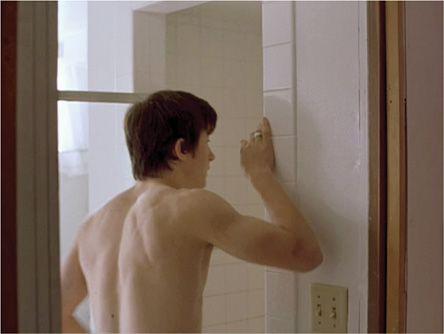
5.205 We expect a reverse shot to reveal what she sees. Instead, we get a flashback to earlier that day when the two boys showered together before going to school on their deadly mission.
Could a feature-length movie consist of one long take? Many directors have dreamed of this possibility, but the lengths of film reels have prevented it. A 35mm camera reel typically runs for only 11 minutes, so Hitchcock tried to hide some of
Rope
’s obligatory cuts. Extended 16mm reels of the type Warhol used in
My Hustler
(
5.201
) can run up to 30 minutes. With digital video, however, it is possible to shoot for over two hours on a single tape, and the Russian director Aleksander Sokurov seized this opportunity in his
Russian Ark.
The film consists of a single shot nearly 90 minutes long, as a Steadicam follows over 2000 actors in period costume through St. Petersburg’s immense Winter Palace.
Russian Ark
takes us through several eras of Russian history, culminating in a stupendous ballroom dance and a crowd drifting off into a wintry night
(
5.206
–
5.208
).
Sokurov rehearsed
Russian Ark
for several months and completed the take used in the film on the fourth try.
CONNECT TO THE BLOG
Both
There Will Be Blood
and
The Most Beautiful
contain subtle staging in two unmoving long takes. We compare them in “Hands (and faces) across the table,” at
www.davidbordwell.net/blog/?p=1944
.
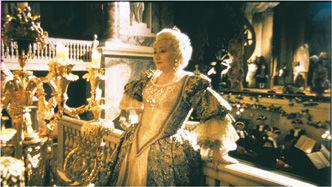
5.206 In
Russian Ark,
one episode takes place in the palace theater, with Catherine the Great pronouncing the rehearsal satisfactory.
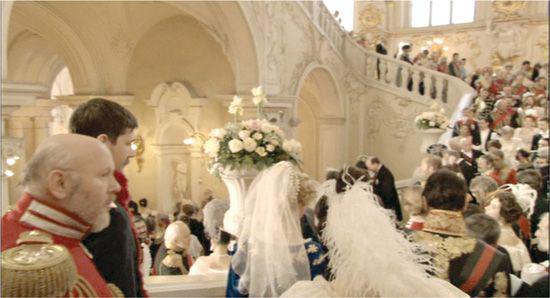
5.207 An hour or so later, still within the same shot, hundreds of aristocrats and officers descend a staircase toward the impending devastation of the Russian Revolution.
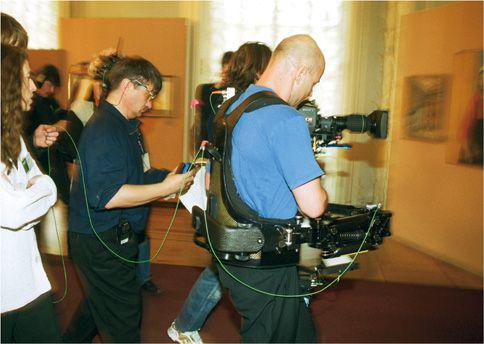
5.208 Crew members moving through the Hermitage Museum, filming
Russian Ark
with a digital camera mounted on a Steadicam (photography by Alexander Belenkiy).
The
Elephant
example suggests that a long take is likely to rely on camera movement. Panning, tracking, craning, or zooming can be used to present continually changing vantage points that are comparable in some ways to the shifts of view supplied by editing.
Very often, frame mobility breaks the long-take shot into significant smaller units. In Mizoguchi’s
Sisters of Gion,
one long take shows a young woman, Omocha, luring a businessman into becoming her patron
(
5.209
–
5.214
).
Though there is no cutting, the camera and figure movements demarcate important stages of the scene’s action.
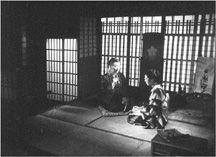
5.209 In
Sisters of Gion,
the long take begins with Omocha and the businessman seated. The camera follows as …
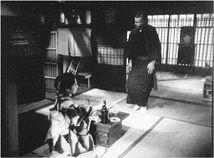
5.212 A second phase of the shot begins as she begins to appeal to his sympathy and he moves to the table …
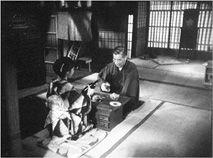
5.213 … and sits down to console her.
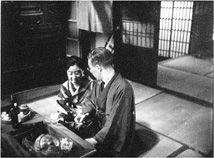
5.214 Finally, the camera moves into a tighter shot as she sits beside him and he succumbs to her advances.
As in this example, long takes tend to be framed in medium or long shots. The camera lingers on a fairly dense visual field, and the spectator has more opportunity to scan the shot for particular points of interest. This is recognized by Steven Spielberg, a director who has occasionally exploited lengthy takes:
I’d love to see directors start trusting the audience to be the film editor with their eyes, the way you are sometimes with a stage play, where the audience selects who they would choose to look at while a scene is being played…. There’s so much cutting and so many close-ups being shot today I think directly as an influence from television.
As we saw in the previous chapter, however, the director can guide the audience’s scanning of the frame through all of the technical resources of mise-en-scene. This is another way of saying that using the long take often puts more emphasis on performance, setting, lighting, and other mise-en-scene factors.
The example from
Sisters of Gion
illustrates another important feature of the long take. Mizoguchi’s shot reveals a complete internal logic—a beginning, middle, and end. As a part of a film, the long take can have its own formal pattern, its own development, its own trajectory and shape. Suspense develops; we start to ask how the shot will continue and when it will end.
